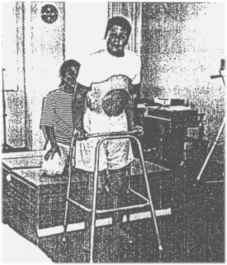|
|
|||||||||||||||
|
Spinal Cord Rehabilitation Using the EIectro-Acuscope and Myopulse By Lynda Hucy (Health Express, June 1983)
Nickolas Culp is fourteen years old. When he was ten, he and his cousin and brother were playing with a gun. Their play ended with an accidental shot fired directly ìntoNickolas'spine. He was diagnosed as a complete paraplegic. Below the point at which his spinal column was injured (eighth thoracic vertebrae), he was told he would never again have sensation or movement. But Elinor Gibbs, director of the Gibbs Institute of Neuro-Kinesiology, didn't believe it. She doesn't believe in such a thing as total and irrevocable paralysis due lo spinal cord darnage. “We consider the problem a loss of body memory, not paralysis," said Gibbs. “We’ re establish that memory in the cerebellum." The Gibbs Institute opened last July in Hollywood, California. The neuro-kinesthetic program that Gibbs developed over the past ten years is a comprehensive treatment for severe intractable disorders of tlie neuromuscular skeletal system. Gibbs and her staff help their patients redevelop a new memory for posture and movement through sensoryinstituted reflexes via the brain's cerebellum. just as muscles respond by reflexes to sensory stimuli, spinal cord victims learn to use this mechanism lo create movement that had previously been impossible.For patients who attend the Gibbs Institute, therapy constitutes a full work out. Among the therapeutic modalities used during each session are, biofeedback, neuro-muscolar, sculpting (deep tissue massage) and treatments onì the Electro-Acuscope and Electro-Myopulse. Tremments are paid for by insurance companies.Patients such as Nickolas Culp are sure that they are getting their money's worth. By the time Nickolas had finished his second day-long session at the Gibbs Institute, he had managed to crawl backwards unassisted. Quite an accomplishment for someone who bad been told he’d never get out of his whellchair. During the 16th session he pedaled a stationary bicycle 1/2mile at eight miles per hour. By the time he completed his 28th session in early December of 1982 he was able to take two steps backwards using parallel bars for support.“At first Nick learned to initiate movement with the upper body. This movement gets trained into the brain, and as the muscles develop, be begins to initiate the movement from lower down. And he starts to get sensory information from lower down, too.The therapist turned to Nick who was resting on a mat after attempting an obstacle course. “Didn’t you say you’re starting to know when your bladder is getting full, that you can fell the pressure?”.” Yep,” returned Nick, turning shy, but obviously proud of the progress. Gibbs insists that patients who spend a full 60 days in her institute will regain not only bladder, but bowel and sexual control. Skeptics abound, saying that it’s impossible to regain motor or sensory nerve usage below the site of a spinal cord injury. But Gibbs undauntedly retorts that her full-time patients are indeed progressing toward what she considers a realistic goal of being able to walk unassisted, using crutches solely for balance.The new area of electro-medicine is one of the prime aids in achieving Gibbs’ goals. Patients at the Gibbs Institute are treated on both the Electro-Acuscope and Electro-Myopulse daily. Both machines utilize a micro-electrical current in first reading, diagnosing, then treating pathological areas of the body. |
| [Home] [Terapia] [Trattamento] [Metodica] [Dati] [Centri] [Distributori] [Lavori] [Corsi] [Link] |
